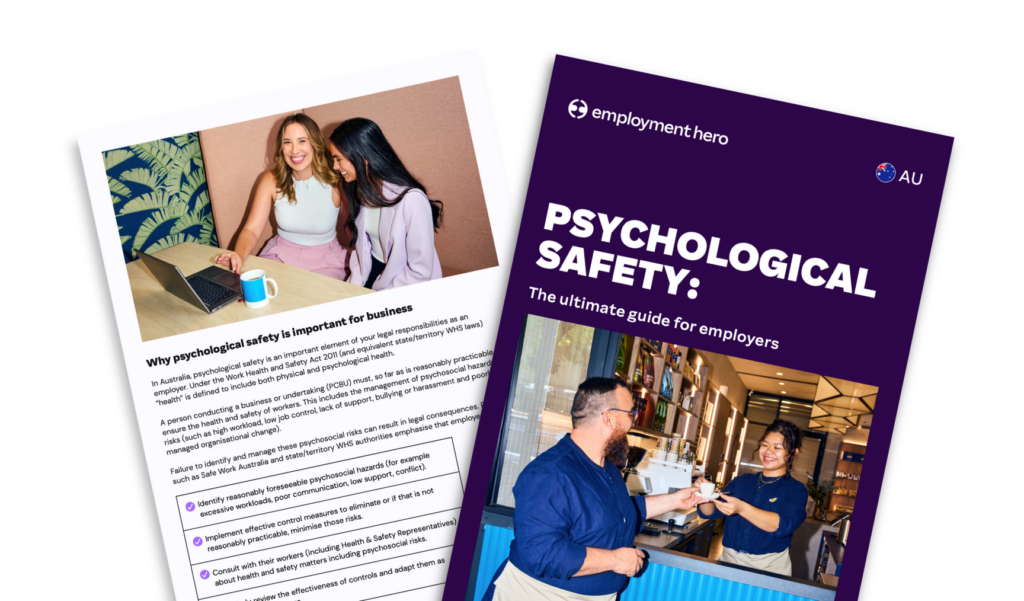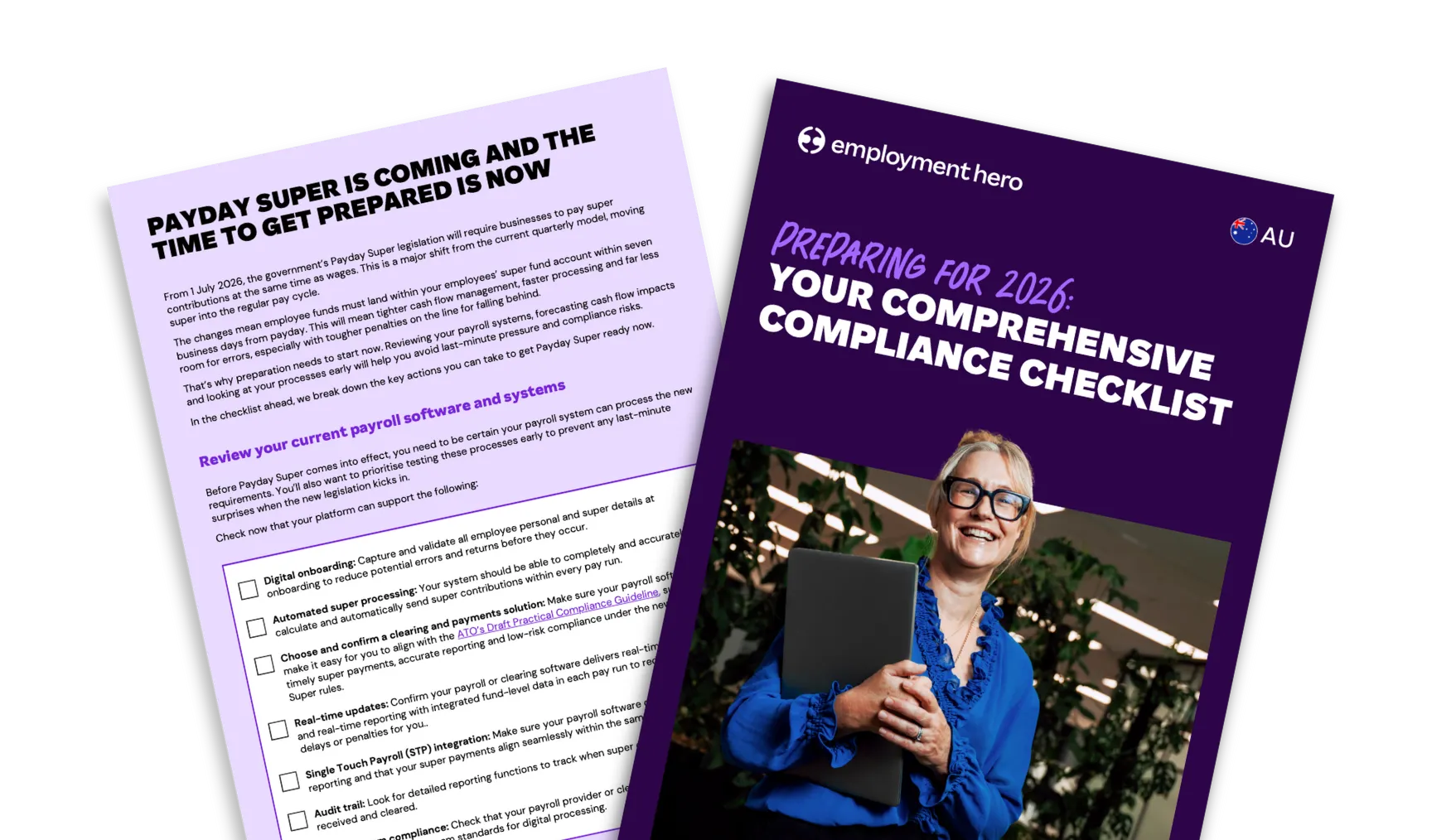A practical guide to psychological safety in the workplace
Published
A practical guide to psychological safety in the workplace
Published
It’s no secret that when employees feel safe to share ideas, raise concerns and speak openly, collaboration and innovation thrive.
This culture of trust and openness doesn’t happen by chance. It’s built with intention, nurtured over time and protected through genuine leadership. This element of workplace culture is known as psychological safety.
Under Australia’s Work Health and Safety (WHS) laws, employers have a duty to protect workers from both physical and psychosocial hazards, i.e. the social, cultural and organisational factors that can cause psychological harm. Building psychological safety helps employers meet these obligations while creating stronger, more resilient teams.

What does this workplace guide cover?
This guide explains all the basics of psychological safety and how to champion it in your business.
In here, you’ll find:
- What is psychological safety and why is it important?
- How to build a psychologically safe workplace.
- Identifying and measuring psychological safety.
- A psychological safety template for you to use.
Download the guide now by filling out the form on the right.
What is psychological safety in the workplace?
A big part of psychological safety is a shared belief that it’s safe to take interpersonal risks. It’s the confidence that you won’t be shamed, rejected or penalised for speaking up with ideas, questions, concerns or mistakes.
Think of it as an invisible safety net that allows vulnerability. When employees feel psychologically safe, they are more likely to:
- Ask for help when they’re stuck.
- Admit they don’t know something.
- Offer a unique opinion or new idea.
- Challenge a decision they believe could be wrong.
- Acknowledge an error before it snowballs.
When you create psychological safety, you’re actively building a resilient and dynamic workforce. It’s the foundation that allows unique skills and diverse perspectives to flourish.
Why does psychological safety matter for team performance?
When employees feel psychologically safe, they unlock their full potential, driving innovation, collaboration and engagement across the business because they feel like they’ll be supported. Here’s why it matters:
Innovation and creativity
Progress stalls when people are afraid to share new ideas or question existing processes. To build psychological safety, you must give your team permission to experiment. Taking risks becomes possible when failure is treated as a learning opportunity, not a punishable offense. This is how you challenge the status quo and find better ways of working.
Employee retention
Top talent doesn’t stay where they don’t feel valued or heard. A toxic or fearful work environment is a major driver of turnover. When you build a workplace where people feel respected and accepted, they are more likely to stay long-term.
Enhanced collaboration
Effective teamwork requires trust and open communication. Psychological safety allows team members from diverse backgrounds to share ideas and collaborate without the friction of interpersonal fear. This leads to better problem-solving and more cohesive, high-performing teams.
Increased engagement
Disengaged employees do the bare minimum. Engaged employees are invested in the company’s success. Building psychological safety is one of the most effective ways to boost engagement, because it allows people to bring their whole selves to work. They’re more willing to go the extra mile when they feel they belong.
Proactive problem-solving
In a psychologically safe workplace, employees are more likely to raise concerns about potential issues before they become crises. Whether it’s a safety concern or an inefficient workflow, this proactive communication helps the business avoid costly mistakes and manage psychosocial hazards effectively.

How can managers prioritise psychological safety?
Managers are on the front lines of culture. Their actions have a direct positive impact on whether their teams feel psychologically safe. Prioritising psychological safety should focus on embedding specific behaviors into daily interactions.
Here are practical ways managers can take the lead:
- Talk about it openly: You can’t improve what you don’t acknowledge. Start by introducing the concept of psychological safety to your team. Explain what it is, why it matters and your commitment to fostering it. This simple act makes safety an explicit team priority.
- Lead by example: The most powerful way to build psychological safety is to model it yourself. Admit your own mistakes. Ask for help when you need it. Show vulnerability. When your team sees you taking interpersonal risks, they’ll understand that it’s safe for them to do the same.
- Encourage questions and feedback: Frame work as a learning process. Actively invite questions and make it clear there’s no such thing as a “stupid” question. When someone offers constructive feedback, thank them for it, even if you disagree. This reinforces that their voice is valued.
- Practice active listening: When a team member speaks, give them your full attention. Actively listen to understand, not just to respond. Paraphrase what they’ve said to confirm your understanding (“So, what I’m hearing is…”). This shows respect and encourages people to share ideas more freely.
- Replace blame with curiosity: When something goes wrong, resist the urge to find who’s at fault. Instead, approach the situation with curiosity. Ask questions like, “What can we learn from this?” or “How can we prevent this from happening again?” A culture of blame destroys safety, while curiosity builds it.
What is impression management and how can teams overcome it?
Impression management is the conscious or subconscious process by which people attempt to influence the perceptions of other people about a person, object or event. In the workplace, this often translates to employees hiding their true thoughts and feelings to look good in front of their boss and peers. They might stay silent instead of asking a question to avoid looking incompetent or agree with a bad idea to be seen as a team player.
This behavior is driven by fear of negative consequences. When psychological safety is low, the energy that should be going toward collaboration and innovation is instead wasted on managing impressions. It stifles creativity, hides critical problems and prevents genuine connection within the team.
Overcoming impression management requires a deliberate effort to build psychological safety. Here are strategies to help your team move past it:
- Acknowledge and normalise vulnerability: Leaders should be the first to admit they don’t have all the answers. By showing their own fallibility, they make it safer for others to do the same.
- Set clear expectations for candor: Explicitly state that you expect and value open, honest dialogue. Frame challenging discussions and diverse perspectives as essential for team success.
- Create structures for safe feedback: Don’t just hope for open communication, build systems for it. Regular one-on-ones, anonymous surveys and structured retrospectives can provide safe channels for employees to raise concerns and share ideas.
- Reward courageous behavior: When an employee challenges a process or admits a mistake, publicly praise their courage. This sends a powerful signal to the rest of the team that such behavior is not only safe but also valued.
What tools can employers use to measure and build psychological safety?
You can’t manage what you don’t measure. To effectively build psychological safety, you need to know where you stand. Several tools and frameworks can help you get a clear picture of your current state and track your progress over time.
Surveys and pulse checks
Anonymous surveys are one of the most effective ways to gauge psychological safety. You can use validated survey instruments or create your own with questions like, “I feel safe to take a risk on this team,” or “Team members can bring up problems and tough issues.” Regular pulse checks can help monitor trends.
Employee management software
Using dedicated employee management software can streamline the process of gathering feedback. Features like anonymous reporting, 360-degree feedback and goal-setting tools help foster a culture of continuous improvement and open communication. These platforms provide a structured way to have conversations that might otherwise feel difficult.
Leadership development frameworks
Psychological safety starts at the top. Investing in leadership training that focuses on emotional intelligence, active listening and coaching can equip your managers with the skills they need to create psychologically safe teams. Frameworks that teach leaders how to handle conflict constructively are valuable.
Formal policies and procedures
Well-defined workplace policies create a clear and consistent framework for behavior. Grievance handling policies and conflict management guides provide employees with a safe and structured process to raise concerns. Having clear policies demonstrates a commitment to fairness and safety in the workplace.

How can you maintain psychological safety over time?
Building psychological safety is an ongoing commitment. The momentum you build can easily be lost if you don’t actively work to maintain it. Sustaining a psychologically safe work environment requires continuous effort, monitoring and adaptation.
Here are key strategies for long-term success:
- Integrate it into onboarding: Start from day one. Make psychological safety a core part of your onboarding process for new hires. Explain what it means at your company and what behaviors are expected. This sets the tone for their entire tenure.
- Monitor progress regularly: Continue using surveys and other tools to keep a pulse on how your teams are feeling. Share the results transparently, and discuss them with your teams. This shows you’re serious about improvement and keeps everyone accountable.
- Embed it in performance reviews: Make behaviors that support psychological safety, like constructive feedback or collaborating effectively, part of your performance management process. This reinforces their importance.
- Celebrate successes and learn from setbacks: When you see a team demonstrating great psychological safety, celebrate it. When you encounter a setback, treat it as a learning opportunity. Facilitate open discussions about what went wrong and how you can get back on track.
- Adapt your practices: The needs of your team will change over time. Be prepared to adjust your strategies. What works for a team of 10 might not work for a team of 50. Stay flexible and listen to your employees.
What are the barriers to psychological safety, and how can you overcome them?
Despite the best intentions, several common barriers can derail your efforts to create a psychologically safe workplace. Being aware of these obstacles is the first step to overcoming them.
Fear of conflict
Many people are conflict-avoidant. They’d rather stay silent than risk an uncomfortable conversation. To overcome this, provide training on constructive conflict resolution. Reframe conflict as a necessary part of collaboration and innovation, not as a personal attack.
Lack of trust in leadership
If employees don’t trust their leaders, they won’t feel safe. This often stems from a lack of transparency or inconsistent behavior. To overcome this, leaders must be consistent, transparent and follow through on their commitments. Trust is built through actions, not words.
Hierarchical culture
In a rigid, top-down culture, employees may feel it’s not their place to speak up or challenge authority. To overcome this, leaders need to flatten communication channels. Actively solicit input from employees at all levels and demonstrate their ideas are valued.
Pressure for unanimity
Some teams prize agreement above all else, which can lead to groupthink. To overcome this, deliberately build in moments for dissent. Assign a “devil’s advocate” in meetings or use brainstorming techniques that encourage diverse perspectives.
Ignoring psychosocial hazards
Failure to address psychosocial hazards like high workload, lack of role clarity or workplace bullying will quickly erode any safety you’ve built. To overcome this, conduct regular risk assessments and take concrete actions to mitigate identified hazards. Having a clear Workplace Health and Safety policy is also crucial.
By systematically identifying and addressing these barriers, you can clear the path to building and sustaining a truly psychologically safe workplace.
Download the full psychological safety guide
Ready to transform your workplace into a hub of innovation, engagement and high performance? Building psychological safety is the key. It’s time to move beyond theory and put these principles into practice.
Our complete guide provides the tools, templates and in-depth strategies you need to foster a fearless organisation. Learn how to conduct a psychological safety audit, facilitate productive conversations and embed these practices into your company’s DNA.
Download the psychological safety guide now by filling out the form on the right.
Disclaimer: The information in this guide is current as at November 2025, and has been prepared by Employment Hero Pty Ltd (ABN 11 160 047 709) and its related bodies corporate (Employment Hero). The views expressed in this guide are general information only, are provided in good faith to assist employers and their employees, and should not be relied on as professional advice. The Information is based on data supplied by third parties. While such data is believed to be accurate, it has not been independently verified and no warranties are given that it is complete, accurate, up to date or fit for the purpose for which it is required. Employment Hero does not accept responsibility for any inaccuracy in such data and is not liable for any loss or damages arising either directly or indirectly as a result of reliance on, use of or inability to use any information provided in this guide. You should undertake your own research and to seek professional advice before making any decisions or relying on the information in this guide.
Register for the guide
Related Resources
-
 Read more: HR Managers: Don’t just survive the festive season, master it
Read more: HR Managers: Don’t just survive the festive season, master itHR Managers: Don’t just survive the festive season, master it
Make year-end easier: manage leave, payroll, parties and shutdowns with confidence. Get practical tips for Australian SMEs. Download the free…
-
 Read more: Preparing for 2026: Your Compliance Checklist
Read more: Preparing for 2026: Your Compliance ChecklistPreparing for 2026: Your Compliance Checklist
Get your business ready for the 1 July 2026 changes. See practical steps for Payday Super, cash flow planning and…
-
 Read more: Monthly business budget template for employers
Read more: Monthly business budget template for employersMonthly business budget template for employers
Plan your monthly income and expenses with our free monthly business budget template. Download today to track cash flow and…























